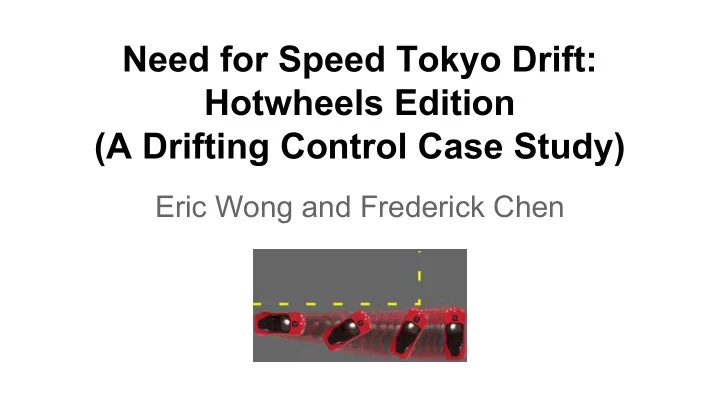

Need for Speed Tokyo Drift: Hotwheels Edition (A Drifting Control Case Study) Eric Wong and Frederick Chen
Motivation Pop culture
Motivation Pop culture Drifting competitions
Motivation Pop culture Drifting competitions Adverse conditions (snow, rain)
Motivation Pop culture Drifting competitions Adverse conditions (snow, rain) Goal: Understand and create models that work when traction is lost
Literature Survey Stability control ● Ackermann, 1997 ● Liebemann et al. ● Kiyotaka et al., 2009
Literature Survey Stability control Formal verification ● Ackermann, 1997 ● Eyisi et al., 2013 (adaptive cruise ● Liebemann et al. control) ● Kiyotaka et al., 2009 ● Loos & Platzer, 2011 (crossing intersections)
Literature Survey Stability control Formal verification ● Ackermann, 1997 ● Eyisi et al., 2013 (adaptive cruise ● Liebemann et al. control) ● Kiyotaka et al., 2009 ● Loos & Platzer, 2011 (crossing intersections) Simulation-based drifting ● Ellefsen, 2012 ● Jakobsen, 2011
Literature Survey Stability control Formal verification ● Ackermann, 1997 ● Eyisi et al., 2013 (adaptive cruise ● Liebemann et al. control) ● Kiyotaka et al., 2009 ● Loos & Platzer, 2011 (crossing intersections) Simulation-based drifting ● Ellefsen, 2012 ● Jakobsen, 2011 Simulations don’t prove reliability of the system!
Research Questions 1. Can we make and formally verify a reliable controller that safely drifts to the desired range direction? 2. How close can we get to the desired direction?
Drifting motion
Drifting motion
Drifting motion
Drifting motion
Linear + Circular Motion
Linear + Circular Motion
Model Differential Equations linear motion
Model Differential Equations circular motion on unit circle linear motion
Model Differential Equations circular motion on unit circle linear motion angular velocity (turning rate)
Model Differential Equations circular motion on unit circle linear motion angular velocity (turning rate) We use KeYmaera, a hybrid verification tool for hybrid systems that supports differential dynamic logic to model and prove our properties
Model Differential Equations circular motion on unit circle linear motion angular velocity (turning rate) We use KeYmaera, a hybrid verification tool for hybrid systems that supports differential dynamic logic to model and prove our properties Controller decision How fast should we turn in order for dx to land in the interval (dx l ,dx u )?
Taylor Series Bounds Taylor series bounds provide provable differential invariants
Taylor Series Bounds Taylor series bounds provide provable differential invariants Use these bounds to find a good angular velocity
Our Controller Guarantees 1. Our controller is guaranteed to not drift off the road 2. Our controller is guaranteed to drift to a direction with within an arbitrary range (dx l , dx u )
Our Controller Guarantees 1. Our controller is guaranteed to not drift off the road 2. Our controller is guaranteed to drift to a direction with within an arbitrary range (dx l , dx u ) Additional Assumption: (dx l , dx u ) must satisfy
Additional Assumption The minimum range enforced by this condition is reasonably small dxl = -0.5 : 23.19 degrees dxl = 0.0 : 9.78 degrees dxl = 0.5 : 2.89 degrees Increasing the order of the Taylor series approximation relaxes this constraint, feasible up to order 8, due to closed form solutions for degree 4 polynomials
Conclusions 1. Can we make and formally verify a controller that drifts safely to the desired direction? 2. How close can we get to the desired direction?
Conclusions 1. Can we make and formally verify a controller that drifts safely to the desired direction? Formally verified controller that stays on the road and drifts to within the target range of direction 2. How close can we get to the desired direction?
Conclusions 1. Can we make and formally verify a controller that drifts safely to the desired direction? Formally verified controller that stays on the road and drifts to within the target range of direction 2. How close can we get to the desired direction? Using a 4th order Taylor approximation our controller can get reasonably small intervals of desired turn, with the potential to go up to an 8th order approximation if necessary
Parallel Park
Future Work Additional Variables to Closer Model Reality
Future Work Additional Variables to Planning for Unexpected Closer Model Reality Loss of Traction
Future Work Additional Variables to Planning for Unexpected Acceleration while Closer Model Reality Loss of Traction drifting
Questions?
Recommend
More recommend